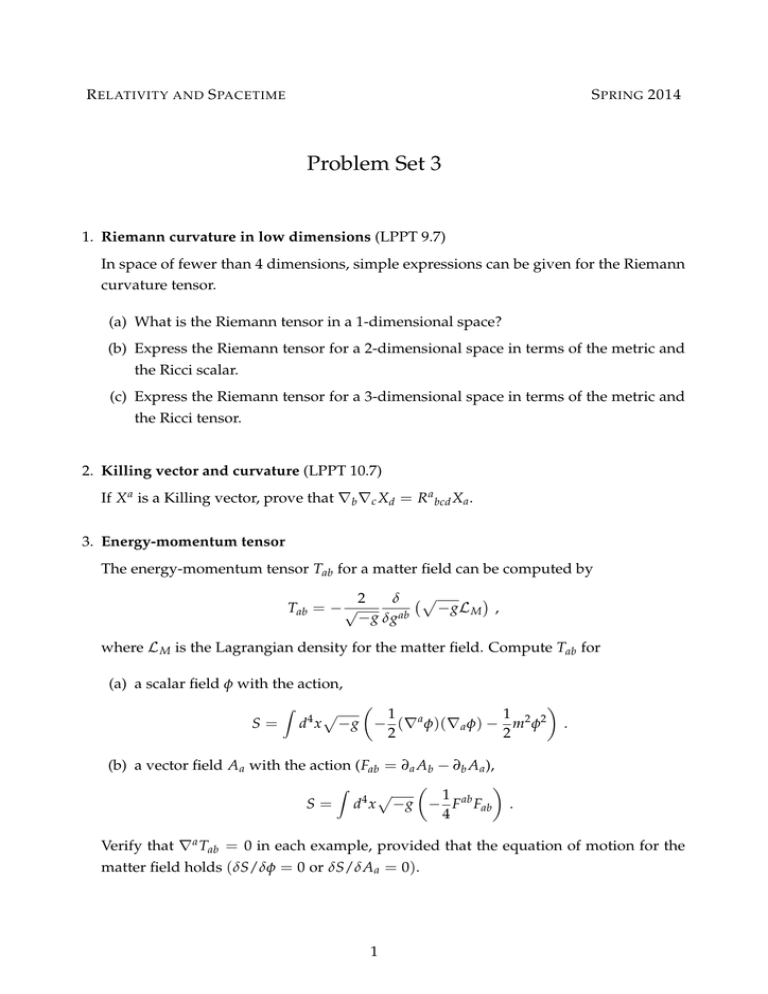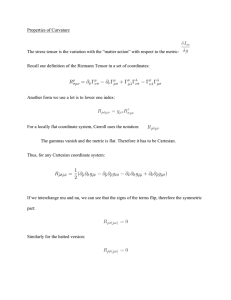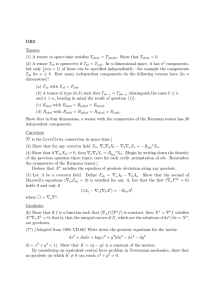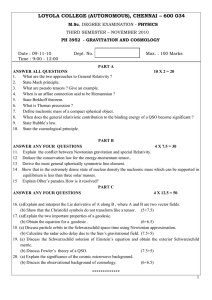Problem Set 3
advertisement

R ELATIVITY AND S PACETIME S PRING 2014 Problem Set 3 1. Riemann curvature in low dimensions (LPPT 9.7) In space of fewer than 4 dimensions, simple expressions can be given for the Riemann curvature tensor. (a) What is the Riemann tensor in a 1-dimensional space? (b) Express the Riemann tensor for a 2-dimensional space in terms of the metric and the Ricci scalar. (c) Express the Riemann tensor for a 3-dimensional space in terms of the metric and the Ricci tensor. 2. Killing vector and curvature (LPPT 10.7) If X a is a Killing vector, prove that rb rc Xd = R a bcd Xa . 3. Energy-momentum tensor The energy-momentum tensor Tab for a matter field can be computed by Tab = p 2 d p gL M , g dg ab where L M is the Lagrangian density for the matter field. Compute Tab for (a) a scalar field f with the action, S= Z 4 d x p g ✓ 1 a (r f)(r a f) 2 1 2 2 m f 2 (b) a vector field A a with the action (Fab = ∂ a Ab ∂b A a ), ✓ ◆ Z p 1 ab 4 S= d x g F Fab . 4 ◆ . Verify that r a Tab = 0 in each example, provided that the equation of motion for the matter field holds (dS/df = 0 or dS/dA a = 0). 1 R ELATIVITY AND S PACETIME P ROBLEM S ET 3 4. Spherically symmetric, static geometry Consider the following ansatz for a spherically symmetric, static geometry: ds2 = e2F(r) dt2 + e 2Y(r ) dr2 + r2 (dq 2 + sin2 qdf2 ). (a) In the coordinate basis, compute the components of the Levi-Civita connection a ), the Riemann tensor ( R a (Gbc bcd ), the Ricci tensor (R ab ) and the Ricci scalar (R). (b) Show that the energy-momentum conservation for perfect fluid in this geometry implies (Tab = (r + p)Ua Ub + pgab ) (r + p) dF = dr dp , dr and gives no further restrictions. (c) Consider the vacuum Schwarzschild geometry: e2F = e2Y = 1 2GM/r. Find a new coordinate r̃ (r ) which brings the metric to the form ⇣ ⌘ 2 2A(r̃ ) 2 2B(r̃ ) 2 2 2 2 2 ds = e dt + e , dr̃ + r̃ (dq + sin qdf ) . 5. Angular momentum in Schwarzschild geometry (LPPT 15.1) Prove that the total angular momentum squared, L2 = p2q + p2f / sin2 q, is a constant of motion along any Schwarzschild geodesic. 6. Correction to Kepler’s third law Recall that the period of an elliptic Kepler orbit is given by 2pa3/2 , ( GM)1/2 T= where a is the semi-major axis of ellipse. (a) Compute the leading post-Newtonian correction to this period. Express the answer in a and the eccentricity # of ellipse. (b) Estimate the numerical value of the correction for Mercury. 2 R ELATIVITY AND S PACETIME P ROBLEM S ET 3 7. Einstein ring A special case of gravitational lensing (bending of light due to a massive spherical body) occurs when the source, lens and observer are all exactly aligned. Let ds and dl be the distance from the observer to the source and the lens, respectively. Assume that ds and dl are both much larger than the ‘size’ of the lens, so that a small angle approximation is valid; this is almost always true for astronomical objects. Assume also that the source, lens and observer are all static in a common rest frame in an asymptotically Minkowski spacetime. Show that the size of the Einstein ring in terms of the angle measured by the observer is s 4GM (ds dl ) qo = . ds dl 8. Signal from a particle falling into a black hole (Schutz 11.21) A particle of mass m falls radially toward the horizon of a Schwarzschild black hole of mass M. The geodesic it follows has the conserved ‘energy per mass’ e = 0.95. (a) Find the proper time required to reach r = 2GM from r = 3GM. (b) Find the proper time required to reach r = 0 from r = 2GM. (c) Find its four-velocity components at r = 2.02GM. (d) As it passes r = 2.02GM, it sends a photon out radially to a distant stationary observer. Compute the redshift of the photon when it reaches the observer. Don’t forget to allow for the Doppler part of the redshift caused by the particle’s velocity. 3






